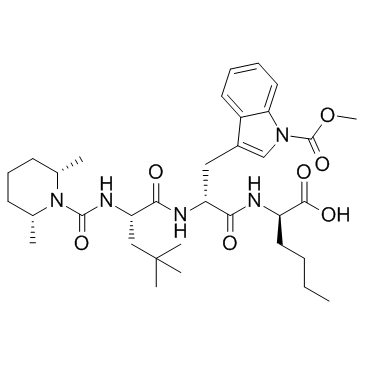173326-37-9
| Name | (2R)-2-[[(2R)-2-[[(2S)-2-[[(2R,6S)-2,6-dimethylpiperidine-1-carbonyl]amino]-4,4-dimethylpentanoyl]amino]-3-(1-methoxycarbonylindol-3-yl)propanoyl]amino]hexanoic acid |
|---|---|
| Synonyms |
UNII-6MB0YNA8DJ
BQ-788 free acid BQ-788 |
| Description | BQ-788 is a potent, selective ETB receptor antagonist with IC50 of 1.2 nM for inhibition of ET-1 binding to human Girardi heart cells, poorly inhibiting the binding to ETA receptors in human neuroblastoma cell line SK-N-MC cells with IC50 of 1300 nM. |
|---|---|
| Related Catalog | |
| Target |
IC50: 1.2 nM (ETB) |
| In Vitro | BQ-788 potently and competitively inhibits 125I-labeled ET-1 binding to ETB receptors in human Girrardi heart cells (hGH) with an IC50 of 1.2 nM, but only poorly inhibits the binding to ETA receptors in human neuro-blastoma cell line SK-N-MC cells (IC50, 1300 nM). BQ-788 shows no agonistic activity up to 10 μM and competitively inhibits thevasoconstriction induced by an ETB-selective agonist (pA2, 8.4). BQ-788 also inhibits several bioactivities of ET-1, such as bronchoconstriction, cell proliferation, and clearance of perfused ET-1[1]. |
| In Vivo | BQ-788 (3 mg/kg/h, i.v.) completely inhibits a pharmacological dose of ET-1- or sarafotoxin6c (0.5 nmol/kg, i.v.)-induced ETB receptor-mediated depressor, but not pressor responses in conscious rats. Furthermore, BQ-788 markedly increases the plasma concentration of ET-1, which is considered an index of potential ETB receptor blockade in vivo. In Dahl salt-sensitive hypertensive (DS) rats, BQ-788 (3 mg/kg/h, i.v.) increases blood pressure by about 20 mm Hg. It is reported that BQ-788 also inhibits ET-1-induced bronchoconstriction, tumor growth and lipopolysaccharide-induced organfailure[1]. BQ 788 (3 mg/kg) results in an eightfold leftward shift in the ET-1 dose-response curve, suggesting a significant involvement of ETB dilator receptors[2]. Mice are treated with 30 nmol BQ-788 by intraplantar, reduce mechanical hyperalgesia (47% and 42%), thermal hyperalgesia (68% and 76%), oedema (50% and 30%); myeloperoxidase activity (64% and 32%), and overt-pain like behaviours. Additionally, intraplantar treatment with clazosentan or BQ-788 decreases spinal (45% and 41%) and peripheral (47% and 47%) superoxide anion production as well as spinal (47% and 47%) and peripheral (33% and 54%) lipid peroxidation, respectively[3]. |
| References |
| Molecular Formula | C34H51N5O7 |
|---|---|
| Molecular Weight | 641.79800 |
| Exact Mass | 641.37900 |
| PSA | 159.07000 |
| LogP | 5.93060 |
| Storage condition | 2-8℃ |

